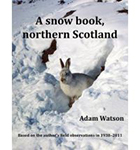Adam Watson has been continuously observing and collecting data about snow in the north-east of Scotland (and particularly in the Cairngorm mountains) since the 1930s, and this important book represents the culmination of that activity. It will have a strong claim in the future to being the standard reference work in the discipline of research into and observation of long-lasting snowpatches and snow-cover in general in the Scottish mountains.
The first five chapters contain the ‘meat’ of the book. These chapters are in the format of academic papers and present and summarise all the data gained from a century of observation of snowpatches throughout the Scottish mountains (by many observers as well as Adam), along with statistical analyses and conclusions about any possible historical trends and correlations. Topics covered include observations of snow cover and snowfalls in summer and autumn, and the persistence or survival of snowpatches until late into the year.
The subsequent chapters are slightly less formal and contain Adam’s many observations, photographs and conclusions concerning various snow-related features in the mountain areas of Scotland, including whether glaciers existed recently in the Cairngorm mountains, avalanches, animal behaviour in snow and the effect of snow cover on rock lichens.
The large format of the book allows for the inclusion in detail of many full-page photographs from Adam’s extensive collection (the large majority in colour) supporting the data and observations in the accompanying text.
Along with ‘Cool Britannia’ (written by Adam in collaboration with Iain Cameron; see my previous blog posting ‘Cool Britannia‘ for a review of this) which was published in 2010, these books represent a valuable archive of data about snowpatches in the Scottish mountains, as well as representing the most up-to-date contemporary research into this discipline. All of the available data from Adam’s substantial 70-year long observing record is summarised and collated, as well as data from all other relevant sources. Full lists of citations are given to all relevant earlier published work, making this book now the most authoritative and reliable reference source material available anywhere for any future discussions and investigations concerning snowpatches in the Scottish mountains or indeed the Scottish mountain environment and climate in general.
These two books are the foundation upon which any future observations of, and research into, snowpatches in Scotland will be built, and Adam is to be congratulated on publishing this work in publicly available books, rather than hidden away in subscription-only academic journals. Although some may be uncomfortable with the fact that the more formally rigorous and traditional academic peer-review process has been bypassed with this material, the scientific quality and value of the content appears to be very high. Opening this data to all eyes means that it is also now possible for anyone to question and judge its merit (a good thing in my opinion), and use as the basis for further academic research. This openness may well also be a more valuable way of stimulating wider and further observation and recording of snowpatches by amateurs in the future (an example of ‘citizen science’; see my previous blog posting ‘The new world of scientific research on the web‘).
This book is intended for a specialist and academically-orientated audience, for which it is invaluable, but anyone with an interest in how snow affects the environment of the Scottish mountains will find this book interesting.

Eddie
There is an article on the BBC news website about Adam Watson here:
http://www.bbc.co.uk/news/uk-scotland-highlands-islands-16980547
Eddie
And an article on the Scotsman website here:
http://www.scotsman.com/scotland-on-sunday/scotland/peter_ross_meet_the_81_year_old_polymath_at_one_with_nature_1_2125185
Eddie
And a video of an interview on the STV website here:
http://local.stv.tv/aberdeen/news/298196-scientists-life-work-in-the-cairngorms-recognised/